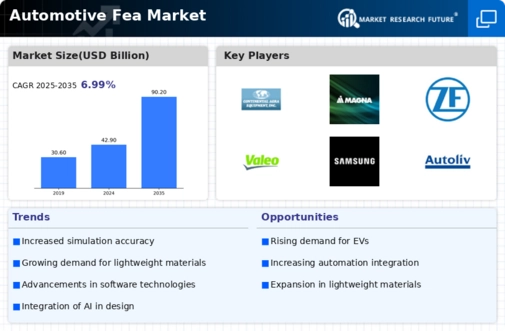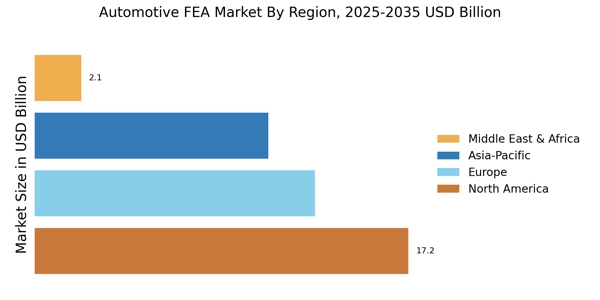Emergence of Advanced Materials
The Automotive Fea Market is witnessing a surge in the adoption of advanced materials, which are essential for enhancing vehicle performance and sustainability. Innovations in composite materials and high-strength alloys are being integrated into vehicle designs, necessitating sophisticated FEA techniques to predict material behavior under various conditions. Market analysis indicates that the use of advanced materials can lead to significant weight reductions and improved durability. As manufacturers increasingly prioritize material innovation to meet consumer demands and regulatory requirements, the Automotive Fea Market is poised for growth, driven by the need for advanced FEA solutions that can effectively analyze these new materials.
Rising Demand for Lightweight Vehicles
The Automotive Fea Market is experiencing a notable shift towards lightweight vehicle designs, driven by consumer preferences for fuel efficiency and reduced emissions. Manufacturers are increasingly utilizing finite element analysis (FEA) to optimize materials and structures, ensuring that vehicles meet stringent performance criteria while minimizing weight. This trend is underscored by data indicating that lightweight vehicles can improve fuel economy by up to 20%. As automakers strive to comply with environmental regulations, the demand for advanced FEA tools that facilitate the design of lightweight components is likely to surge, thereby propelling growth in the Automotive Fea Market.
Increased Focus on Safety and Crashworthiness
Safety remains a paramount concern in the automotive sector, driving advancements in the Automotive Fea Market. Manufacturers are increasingly employing finite element analysis to simulate crash scenarios and assess vehicle safety performance. This focus on crashworthiness is reflected in regulatory requirements that mandate rigorous testing and validation of vehicle designs. Data indicates that vehicles designed with advanced FEA techniques can achieve higher safety ratings, which is a critical selling point for consumers. As safety standards continue to evolve, the Automotive Fea Market is likely to see heightened demand for innovative FEA solutions that enhance vehicle safety and compliance.
Growing Investment in Research and Development
Investment in research and development (R&D) is a key driver of innovation within the Automotive Fea Market. As companies seek to maintain competitive advantages, they are allocating substantial resources to develop cutting-edge FEA tools and methodologies. This trend is supported by data showing that R&D spending in the automotive sector has increased significantly, with many firms recognizing the importance of simulation technologies in accelerating product development cycles. The emphasis on R&D not only fosters technological advancements but also enhances the overall capabilities of the Automotive Fea Market, enabling manufacturers to create more efficient and effective vehicle designs.
Integration of Electric and Autonomous Vehicles
The Automotive Fea Market is significantly influenced by the integration of electric and autonomous vehicles. As the automotive sector transitions towards electrification, the complexity of vehicle design increases, necessitating advanced simulation techniques such as FEA. This is particularly relevant in the development of battery systems and structural components that must withstand various operational stresses. Market data suggests that the electric vehicle segment is projected to grow at a compound annual growth rate (CAGR) of over 20% in the coming years. Consequently, the demand for sophisticated FEA tools that can address the unique challenges posed by electric and autonomous vehicle designs is expected to rise, enhancing the Automotive Fea Market.


















Leave a Comment